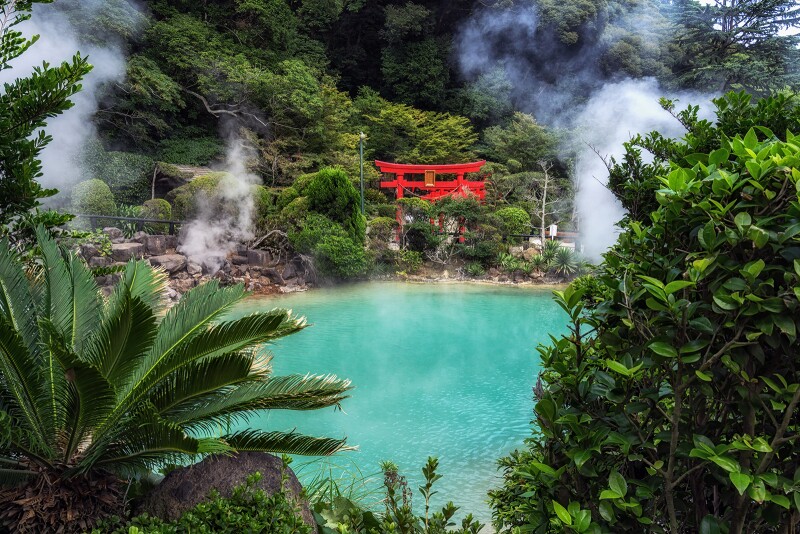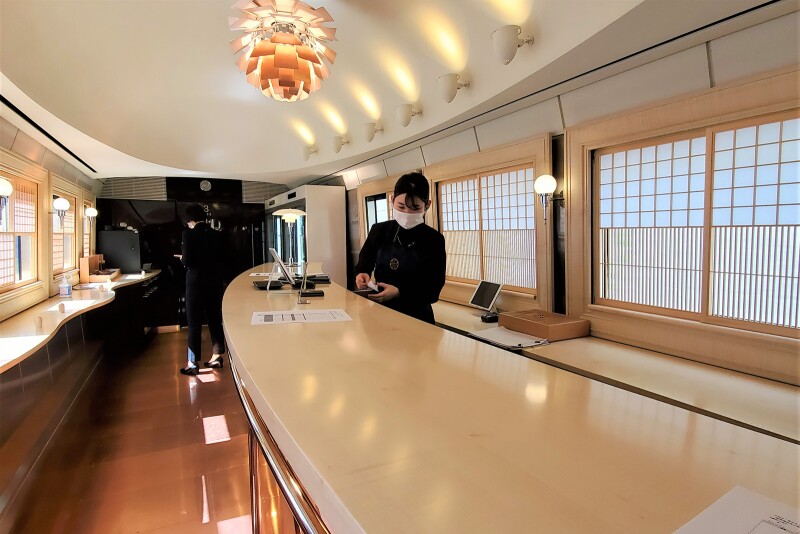Japan may still be off limits to tourists from the United States, but if you’re plotting out an itinerary for a trip once borders do reopen, you’re going to want to add this new luxury sightseeing train to your itinerary.
JR Kyushu launched service in October on its new 36+3 train, a jet-black refurbished 787 series electric train with completely renovated interiors done by the same designer as Kyushu’s famous Seven Stars sleeper train. One of the most luxurious trains in the world, the Seven Stars only has 14 suites and regularly sells out months in advance. Offering day trips instead of overnight accommodations, the 36+3 operates five different scenic routes throughout Kyushu, Japan’s southernmost main island known for its hot springs, springtime azalea bloom, and the largest active volcano in the country, Mount Aso.

The 36+3 train is a refurbished 787 series electric train.
Courtesy of JR Kyushu
What does the name 36+3 mean?
The “36” in the train’s name comes from Kyushu being the 36th largest island in the world, while the “+3” represents the railway company, Kyushu locals, and customers coming together, JR Kyushu says. There’s also a little bit of wordplay in the name, too. The number 39 in Japanese is read as “san-kyu” which is similar to how “thank you” is pronounced (in fact, many people in Japan use “39” when texting as shorthand for “thanks”).

Private compartments are decorated with Western-style sofas, tables, and lamps.
Courtesy of JR Kyushu
What’s it like on the inside?
Similar to the Seven Stars train, the interiors of the six train cars on the 36+3 blend classic Japanese and modern Western styles, including shoji screen doors and a special type of latticework called “Okawa kumiko,” which comes from the island’s Fukuoka Prefecture.
In cars one and two, travelers will find 13 private compartments outfitted with Western-style couches and tables that fit up to 6 people each (the train has a total capacity of 105 passengers). Car three is the bar car where drinks and snacks like sake and local Kyushu cuisine like seafood and wagyu beef are sold, while the lounge (pictured at the top of the article) is in car four and has an arched latticework ceiling and several small dining tables for passengers.
Cars five and six offer regular seating and have tatami mat floors—a first for JR Kyushu—made with rush grass from the island’s Kumamoto Prefecture. Following Japanese etiquette, guests sitting in the cars with tatami mat floors must remove their shoes before entering.

On the weekends, the 36+3 train passes through the city of Beppu, which is famous for its hot springs.
Photo by Shutterstock
Where does it go and what can you see along the way?
The five routes of the 36+3 train make a circuit around the perimeter of Kyushu island, with stops in all seven prefectures. On Thursdays, the train runs from Hakata in the north down the island’s west coast in the Kumamoto Prefecture offering spectacular views of the East China Sea along the way. On Friday, the train cuts across the island’s south from Kagoshima-Chuo to Miyazaki Airport and makes a lunch stop at Osumi Okawara Station, where you can enjoy views of Kinko Bay and the Sakurajima volcano.
On Saturdays, it runs along the eastern coast of Kyushu to Beppu, with a stop in Saiki City so guests can buy such local specialities as black tea grown in the mountains and Japanese chestnut jam. After leaving Beppu on Sundays, the train makes its way across the northern coastline—look forward to views of Beppu Bay on one side of the train and the mountains of Oita Prefecture on the other. Finally, the Monday route takes travelers from Hakata Station to the city of Nagasaki with a stop in a historical town known for its sake breweries.

Travelers can purchase Japanese sake and snacks in the bar car.
Courtesy of JR Kyushu
How much does it cost?
Depending on the route, ticket prices with meal plans for adults range from 12,000 yen (US$116) to 30,000 yen (US$290). Advanced reservations are required for all cars of the train.
>> Next: Kruger National Park’s Newest Luxury Hotel Is in a Train on a Bridge








